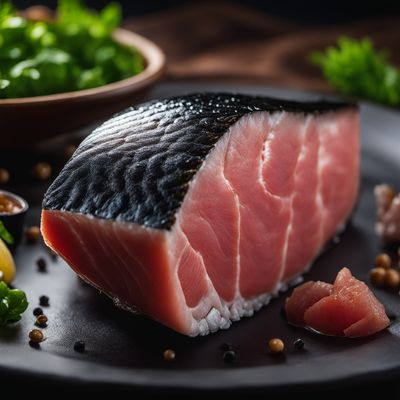
Ingredient
Tuna, longtail
The Ocean's Swift Hunter
Tuna, longtail is a species of tuna that inhabits tropical and subtropical waters. It is characterized by its streamlined body, metallic blue-black coloration on the upper body, and silver-white underside. The flesh of longtail tuna is firm, meaty, and rich in flavor, making it suitable for various culinary preparations, such as grilling, searing, or raw consumption in sushi and sashimi.
Origins and history
Longtail tuna is found in the Indian and Pacific Oceans, particularly in the waters of Southeast Asia, Australia, and the Pacific Islands. It has been an important food source for coastal communities for centuries and continues to be a valuable commercial fishery today.
Nutritional information
Longtail tuna is an excellent source of lean protein, omega-3 fatty acids, and various vitamins and minerals. It is low in saturated fat and calories, making it a healthy choice for seafood lovers.
Allergens
Fish allergies are the most common allergens associated with tuna, including longtail tuna. Individuals with fish allergies should avoid consuming this ingredient.
How to select
When selecting longtail tuna, look for fish with clear, bright eyes, shiny skin, and a fresh, ocean-like smell. The flesh should be firm and spring back when pressed gently. Avoid fish with dull eyes, discolored skin, or a strong fishy odor.
Storage recommendations
To maintain the freshness and quality of longtail tuna, store it in the refrigerator at temperatures below 40°F (4°C). Keep it wrapped in plastic or place it in an airtight container to prevent any odors from contaminating the fish. Consume within a day or two for the best flavor and texture.
Preparation tips
Longtail tuna can be prepared in various ways, including grilling, searing, baking, or even enjoyed raw in sushi and sashimi. It pairs well with citrus flavors, soy sauce, ginger, and sesame oil.
Culinary uses
Longtail tuna is commonly used in Asian cuisines, particularly Japanese cuisine, where it is highly prized for its quality and flavor. It is also popular in Mediterranean and Latin American cuisines. It is commonly used in dishes like sushi, sashimi, ceviche, and grilled tuna steaks.
Availability
Longtail tuna is commonly available in regions with access to tropical and subtropical waters, such as Southeast Asia, Australia, the Pacific Islands, and parts of the Mediterranean. It is also exported to various countries around the world.
More ingredients from this category

Bullet tuna
The Speedy Predator

Tuna, blackfin
The Ocean's Delicacy: Exploring the Richness of Blackfin Tuna

Tuna, skipjack
The Ocean's Bounty

Tuna, yellowfin
"The Jewel of the Sea: Exploring the Delights of Yellowfin Tuna"

Tuna, bluefin (generic)
The Jewel of the Sea: Exploring the World of Bluefin Tuna

Tuna, bigeye
The Mighty Bigeye Tuna

Albacore
The Mighty Albacore
Recipes using Tuna, longtail » Browse all

Tekkadon - Japanese Tuna Rice Bowl
Ocean Delight: A Flavorful Japanese Tuna Rice Bowl

Chirashizushi with a Twist
Sakura Delight: A Modern Twist on Chirashizushi

Kaisendon - Japanese Seafood Rice Bowl
Ocean Delight: A Flavorful Japanese Seafood Rice Bowl

Masroshi Manado-style
Spicy Tuna Stuffed Pancakes - A Taste of Manado

Tuvalu Coconut Tuna Curry
Island Delight: Tuvalu Coconut Tuna Curry

Hawaiian Tuna Poke Bowl
Aloha Delight: Fresh and Flavorful Hawaiian Tuna Poke Bowl

Maldivian Spiced Tuna Curry
Savory Delight: Maldivian Spiced Tuna Curry

Filipino-style Tuna Sinigang
Savory and Tangy Tuna Sinigang: A Filipino Delight

Miruhulee Boava - Spicy Maldivian Tuna Curry
Fiery Tuna Delight - A Spicy Maldivian Culinary Adventure

Marmitako - Basque Tuna Stew
Savory Delight: Basque Tuna Stew with Potatoes and Peppers

Huaiyang-style Stuffed Tuna
Silken Tuna Delight: Huaiyang-style Stuffed Tuna

Mojama de Atún - Spanish Cured Tuna
Savory Delights: Spanish Cured Tuna - A Taste of Tradition